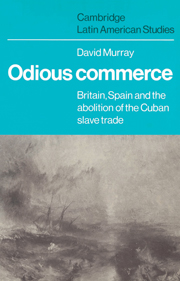Book contents
- Frontmatter
- Contents
- Tables
- Preface
- 1 The ‘opening’ of a legal trade
- 2 Parliament versus Cortes
- 3 Legality and illegality
- 4 The treaty of 1817
- 5 Enforcement and re-enforcement: the attempt to make the slave trade prohibition effective
- 6 The treaty of 1835
- 7 An abolitionist era
- 8 The Turnbull affair
- 9 The Escalera conspiracy
- 10 The penal law of 1845
- 11 Free trade and annexationism
- 12 The failure of the penal law
- 13 A new class of slaves
- 14 The abolition of the Cuban slave trade
- Abbreviations
- Notes
- Bibliography
- Index
- CAMBRIDGE LATIN AMERICAN STUDIES
3 - Legality and illegality
Published online by Cambridge University Press: 16 October 2009
- Frontmatter
- Contents
- Tables
- Preface
- 1 The ‘opening’ of a legal trade
- 2 Parliament versus Cortes
- 3 Legality and illegality
- 4 The treaty of 1817
- 5 Enforcement and re-enforcement: the attempt to make the slave trade prohibition effective
- 6 The treaty of 1835
- 7 An abolitionist era
- 8 The Turnbull affair
- 9 The Escalera conspiracy
- 10 The penal law of 1845
- 11 Free trade and annexationism
- 12 The failure of the penal law
- 13 A new class of slaves
- 14 The abolition of the Cuban slave trade
- Abbreviations
- Notes
- Bibliography
- Index
- CAMBRIDGE LATIN AMERICAN STUDIES
Summary
Force was not one of the weapons in Britain's diplomatic bag of pressures to secure Spain's prohibition of the slave trade. At the same time the British government was not prepared to tolerate the evasion of British laws against slave-trading, either by British subjects engaging in the foreign slave trade or by foreigners smuggling slaves into British possessions.
Two cases, one before the Privy Council and one before the High Court of Admiralty in 1811, showed how far courts would support officers enforcing British laws. In the first, the case of the Amedie, a United States ship believed to be engaged in the slave trade to Cuba, it was stated that since the slave trade had been totally prohibited by Parliament, and pronounced contrary to the principles of justice and humanity, prima facie the trade was illegal. It was then up to the claimants to prove by their own laws, assuming they were not British, the trade was not prohibited.
This principle was used as a weapon against United States participation in the Atlantic slave trade. In a later case the Amedie judgement was interpreted as saying: ‘that the slave trade carried on by a vessel belonging to a subject of the United States is a trade which, being unprotected by the domestic regulations of their Legislature and Government, subjects the vessels engaged in it to a sentence of condemnation.’
- Type
- Chapter
- Information
- Odious CommerceBritain, Spain and the Abolition of the Cuban Slave Trade, pp. 40 - 49Publisher: Cambridge University PressPrint publication year: 1981



